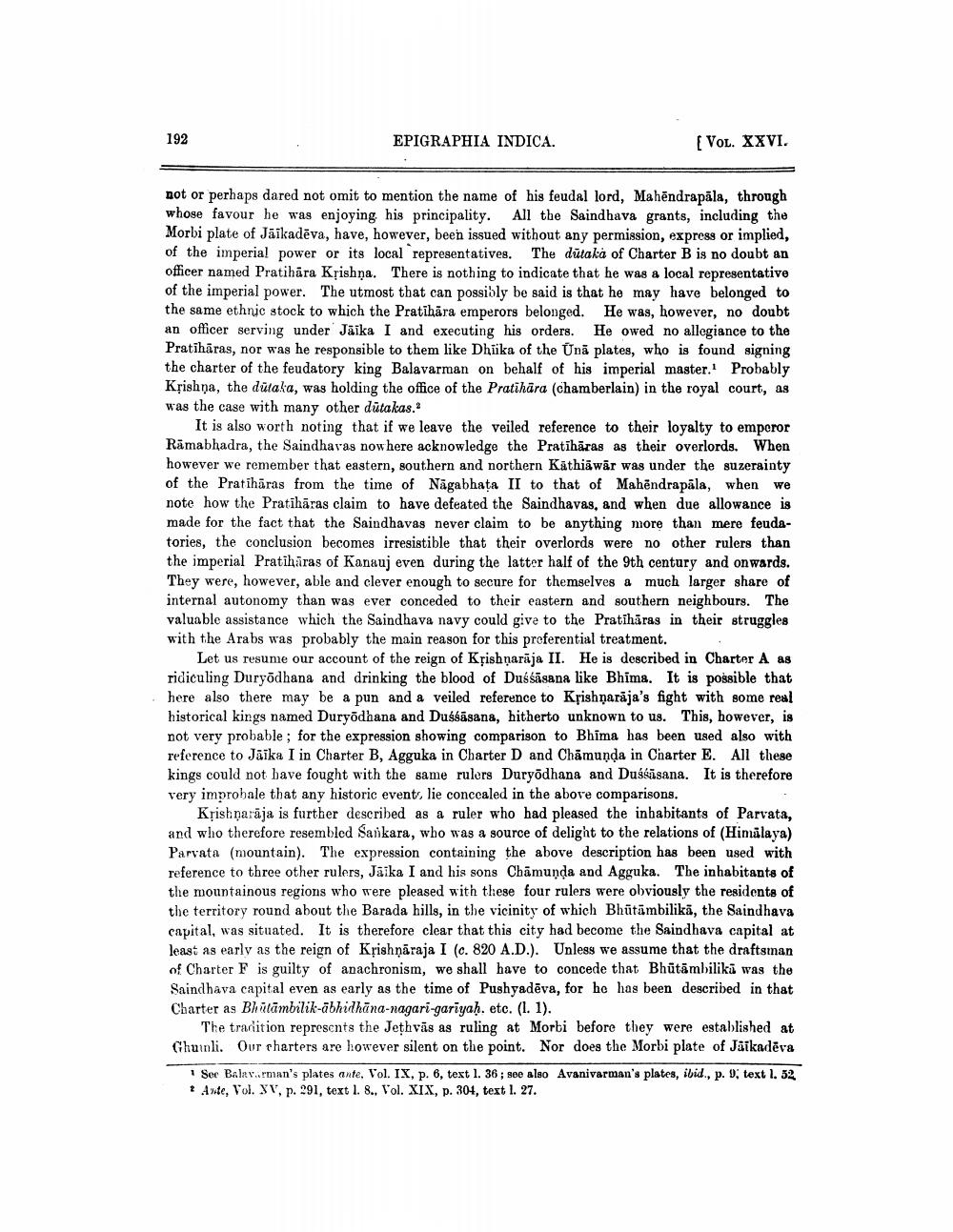________________
192
EPIGRAPHIA INDICA.
[VOL. XXVI.
not or perhaps dared not omit to mention the name of his feudal lord, Mahendrapāla, through whose favour he was enjoying his principality. All the Saindhava grants, including the Morbi plate of Jāikadēva, have, however, been issued without any permission, express or implied, of the imperial power or its local representatives. The dutaka of Charter B is no doubt an officer named Pratihara Krishna. There is nothing to indicate that he was a local representative of the imperial power. The utmost that can possibly be said is that he may have belonged to the same ethnic stock to which the Pratīhāra emperors belonged. He was, however, no doubt an officer serving under Jāika I and executing his orders. He owed no allegiance to the Pratihāras, nor was he responsible to them like Dhika of the Unā plates, who is found signing the charter of the feudatory king Balavarman on behalf of his imperial master. Probably Krishna, the dütaka, was holding the office of the Pratihāra (chamberlain) in the royal court, as was the case with many other dutakas.
It is also worth noting that if we leave the veiled reference to their loyalty to emperor Rāmabhadra, the Saindhavas nowhere acknowledge the Pratihāras as their overlords. When however we remember that eastern, southern and northern Käthiāwār was under the suzerainty of the Pratihāras from the time of Nāgabhata II to that of Mahendrapāla, when we note how the Pratihāras claim to have defeated the Saindhavas, and when due allowance is made for the fact that the Saindhavas never claim to be anything more than mere feudatories, the conclusion becomes irresistible that their overlords were no other rulers than the imperial Pratihāras of Kanuuj even during the latter half of the 9th century and onwards. They were, however, able and clever enough to secure for themselves a much larger share of internal autonomy than was ever conceded to their eastern and southern neighbours. The valuable assistance which the Saindhava navy could give to the Pratihāras in their struggles with the Arabs was probably the main reason for this preferential treatment.
Let us resume our account of the reign of Krishnarāja II. He is described in Charter A as ridiculing Duryodhana and drinking the blood of Duśśāsana like Bhima. It is possible that here also there may be a pun and a veiled reference to Krishnarāja's fight with some real historical kings named Duryodhana and Duśśāsana, hitherto unknown to us. This, however, is not very probable; for the expression showing comparison to Bhima has been used also with reference to Jāika I in Charter B, Agguka in Charter D and Chāmunda in Charter E. All these kings could not have fought with the same rulers Duryodhana and Duśśisana. It is therefore very improbale that any historic events lie concealed in the above comparisons,
Krishnarāja is further described as a ruler who had pleased the inhabitants of Parvata, and who therefore resembled Sarkara, who was a source of delight to the relations of (Himalaya) Parvata (mountain). The expression containing the above description has been used with reference to three other rulers, Jāika I and his sons Chāmunda and Agguka. The inhabitants of the mountainous regions who were pleased with these four rulers were obviously the residents of the territory round about the Barada hills, in the vicinity of which Bhūtāmbilikā, the Saindhava capital, was situated. It is therefore clear that this city had become the Saindhava capital at least as early as the reign of Krishnaraja I (c. 820 A.D.). Unless we assume that the draftsman of Charter F is guilty of anachronism, we shall have to concede that Bhūtāmbilikū was the Saindhava capital even as early as the time of Pushyadēva, for he has been described in that Charter as Bhatāmbilik-ābhidhāna-nagari-gariyah. etc. (1.1).
The tradition represents the Jethvās as ruling at Morbi before they were established at Ghuli. Our charters are however silent on the point. Nor does the Morbi plate of Jäikadēva
See Balevirman's plates ante, Vol. IX, p. 6, text 1. 36 ; see also Avanivarman's plates, ibid., p. 9; text I. 52 ? Ayte, Vol. V, p. 291, text I. 8., Vol. XIX, p. 301, text I. 27.




